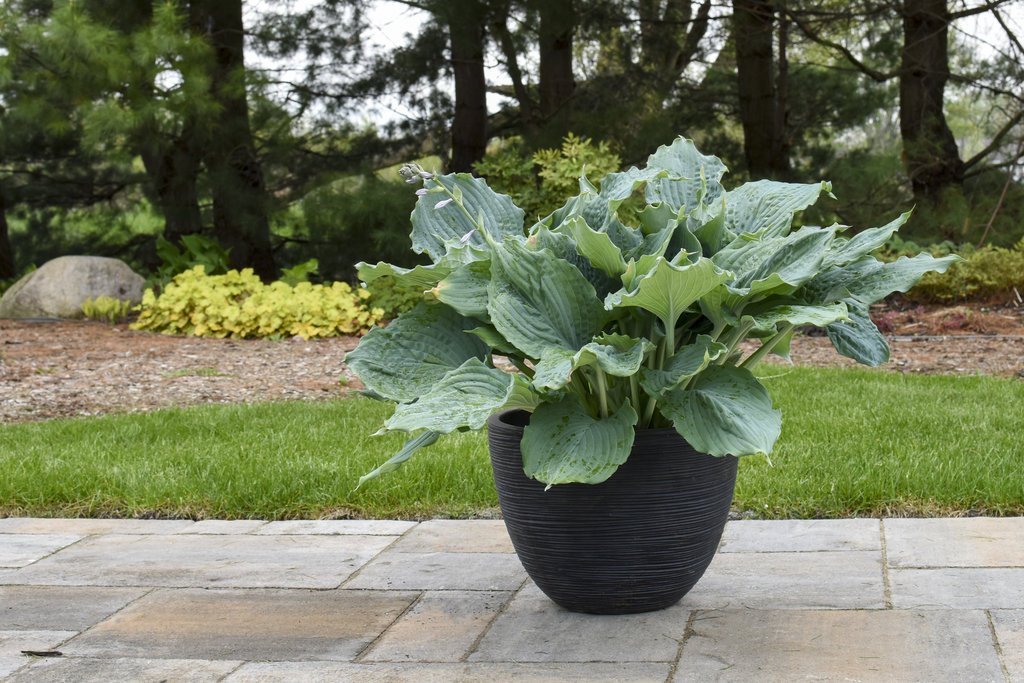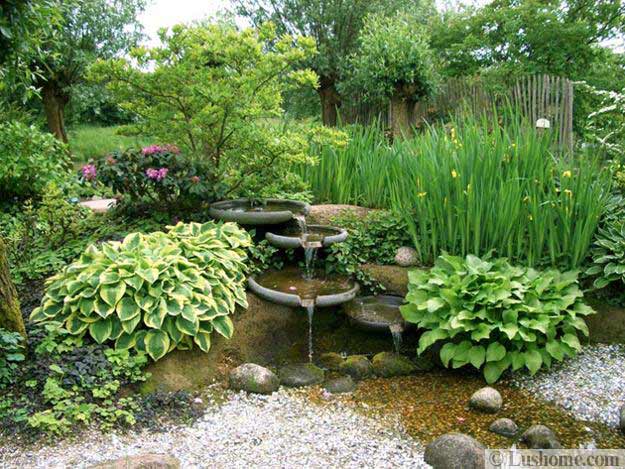Hostas make excellent additions to any garden design with their lush foliage and various colors and textures. With proper planning and placement, you can create a stunning garden showcasing the beauty of these versatile plants.
Whether you want to create a relaxed, naturalistic setting or a formal, structured design, hostas can be easily incorporated into different garden styles. There are countless ways to integrate hostas into your garden design, from border plantings to rock gardens to shady areas.
With their wide range of sizes and shapes, hostas can add depth and visual interest to your outdoor space. So, let’s explore some garden design ideas that feature these beautiful plants.

Credit: www.provenwinners.com
Why Choose Hostas For Garden Designs
Hostas are an excellent choice for garden designs due to their exceptional qualities and versatility. Whether you are a seasoned gardener or a beginner, hostas can add charm and beauty to any outdoor space. Let’s explore some of the reasons why hostas are a popular choice for garden designs.
Variety Of Hostas
One of the remarkable features of hostas is their broad variety. With over 3,000 registered cultivars, you can find hostas in various shapes, sizes, colors, and textures, allowing you to create a garden design that perfectly matches your preferences. From miniature hostas well-suited for rock gardens to giant hostas that make a statement as focal points, there is a hosta for every garden design.
In addition to their size variations, hostas come in various leaf colors and patterns. From the classic green and blue shades to yellow, gold, and variegated leaves, hostas can bring a touch of vibrancy and visual interest to your garden.
You can experiment with different hosta varieties and combine them strategically to create beautiful displays of contrasting colors and textures. Whether you prefer a subtle, monochromatic look or a bold and dramatic statement, the versatility of hostas will enable you to achieve your desired garden design.
Adaptability To Different Conditions
The adaptability of hostas to different environmental conditions is another reason why they are an excellent choice for garden designs. Hostas thrive in shade, making them ideal for areas in your garden that receive limited sunlight. While some hosta varieties can tolerate more sun exposure, most prefer partial or dappled shade conditions.
Furthermore, hostas are known for tolerating various soil types, making them versatile in multiple garden settings. They can grow well in clay, loam, or sandy soil if good drainage is ensured. Therefore, whether you have a moist or dry soil type, you can still incorporate hostas into your garden design.
Hostas’ adaptability extends beyond their tolerance for shade and soil types. They are resilient and can withstand temperature fluctuations, making them suitable for various climate zones. Whether you live in a hot and humid region or a colder climate, hosta varieties can thrive in your specific conditions.
Moreover, hostas make great companion plants for other shade-loving perennials like ferns, astilbes, and heucheras. By combining various plants with hostas, you can create a diverse and visually appealing garden design that enhances the overall beauty of your outdoor space.
Stunning Garden Designs With Hostas
Incorporating hostas into your garden design can add a touch of elegance and beauty. These versatile plants can create stunning landscapes with their lush foliage and vibrant colors. Whether you have a large backyard or a small urban space, hostas can be a perfect addition to any garden. In this post, we will explore three magnificent garden designs that showcase the charm of hostas.
Hosta Border Garden
A hosta border garden is a fantastic way to create visual appeal and define the edges of your garden. You can use hostas as a border plant along walkways, fences, or trees. With their various leaf shapes and shades of green, hostas can create a beautiful contrast against colorful flowers or other foliage. Here are a few tips to create an eye-catching hosta border garden:
- Choose hosta varieties with different leaf sizes and colors to add depth and interest.
- Plant taller hostas towards the back of the border garden, gradually decreasing the height towards the front.
- Complement the hostas with low-growing groundcovers or blooming perennials to create a dynamic display.
- Mulch the soil to retain moisture and suppress weed growth, ensuring your hostas thrive.
Hosta Rock Garden
Consider creating a hosta rock garden if you have a rocky or sloping area in your garden. This design allows you to showcase the unique beauty of hostas while incorporating the natural features of your landscape. Here’s how you can create a stunning hosta rock garden:
- Prepare the rocky area by removing any debris and ensuring proper drainage.
- Choose hosta varieties that tolerate varying light conditions, as rocks may cast shadows.
- Arrange larger rocks as focal points and place hostas around them, creating intriguing pockets of greenery.
- Opt for hosta varieties with contrasting textures to add visual interest.
- To enhance the overall appeal, consider adding other shade-loving plants, such as ferns or wildflowers,
Hosta Shade Garden
Hostas are known for their ability to thrive in shady areas, making them an excellent choice for a shade garden. Their vibrant foliage can brighten up even the darkest corners of your yard. To create a captivating hosta shade garden, follow these steps:
- Choose hosta varieties bred explicitly for shade, adapted to lower light conditions.
- Utilize the different shades of hosta foliage to create visual interest and depth.
- Combine hostas with other shade-loving plants like lily of the valley or astilbe for a lush and contrasting display.
- Place hostas in areas with spotty sunlight or under the canopy of trees.
- Ensure proper soil moisture by using a well-draining organic mulch.
Sustainable Landscaping With Hostas
Garden designs with hostas are not only visually appealing but can also contribute to sustainable landscaping practices. Hostas are versatile and low-maintenance plants that can thrive in various settings, making them an ideal choice for eco-friendly gardens. This article will explore the many benefits of incorporating hostas into your garden design, focusing on water conservation, low maintenance, and ecological advantages.
Water Conservation
Hostas are known for their ability to withstand periods of drought, making them excellent plants for water-conscious gardeners. Their large leaves and extensive root systems help retain moisture in the soil, reducing the need for frequent watering. By incorporating hostas into your garden design, you can significantly minimize water consumption and contribute to conservation efforts.
Low Maintenance
One of the main advantages of incorporating hostas into your garden is their low maintenance requirements. These plants are hardy and resilient, requiring minimal attention once established. Hostas do not need frequent pruning or deadheading, unlike many other garden plants. This low-maintenance characteristic makes them ideal for those with busy schedules or limited gardening experience.
Ecological Benefits
Hostas offer several ecological benefits that make them valuable additions to any garden design. Firstly, their large leaves provide shade and help regulate soil temperature, reducing evaporation and water loss. This shade also creates a favorable habitat for various beneficial insects and wildlife. Also, hostas are known for absorbing air pollutants and improving air quality. By incorporating hostas into your garden, you are enhancing the aesthetic appeal and creating a more eco-friendly environment.

Credit: www.monrovia.com

Credit: www.lushome.com
Frequently Asked Questions Of Garden Designs With Hostas
Can Hostas Be Grown In Full Sun?
Yes, hostas are known to thrive in shade, but some varieties can tolerate full sun conditions. However, providing them with adequate moisture and protection is essential to prevent scorching. Selecting sun-tolerant hosta cultivars and providing regular watering can help ensure successful growth in entire sun areas.
How Do I Prepare My Garden For Hostas?
To prepare your garden for hostas, choose a location with well-draining soil and partial to full shade. Remove any weeds or existing vegetation and loosen the soil in the planting area. Add organic matter, such as compost, to improve soil fertility and drainage.
Finally, dig a hole wide and deep enough to accommodate the hosta’s root system and plant it at the same depth it was in the container.
Can Hostas Be Grown In Containers?
Yes, hostas can be successfully grown in containers if you choose the right pot and provide the necessary care. Select a container with adequate drainage holes and fill it with a high-quality potting mix. Place the container in a shaded or partially shaded area and water regularly to moisten the soil.
Ensure proper ventilation and monitor for pests and diseases to maintain the health of your container-grown hostas.
Conclusion
Hostas are a versatile and beautiful addition to any garden design. With their stunning foliage and easy-to-care-for nature, these plants can add a touch of elegance and flair to any outdoor space. Whether you showcase them in a traditional garden bed or create a stunning display in containers, hostas are sure to impress.
So, get creative with your garden designs, and let hostas be the show’s star. With their wide range of colors and textures, the possibilities are endless. Start creating your dream garden today!

